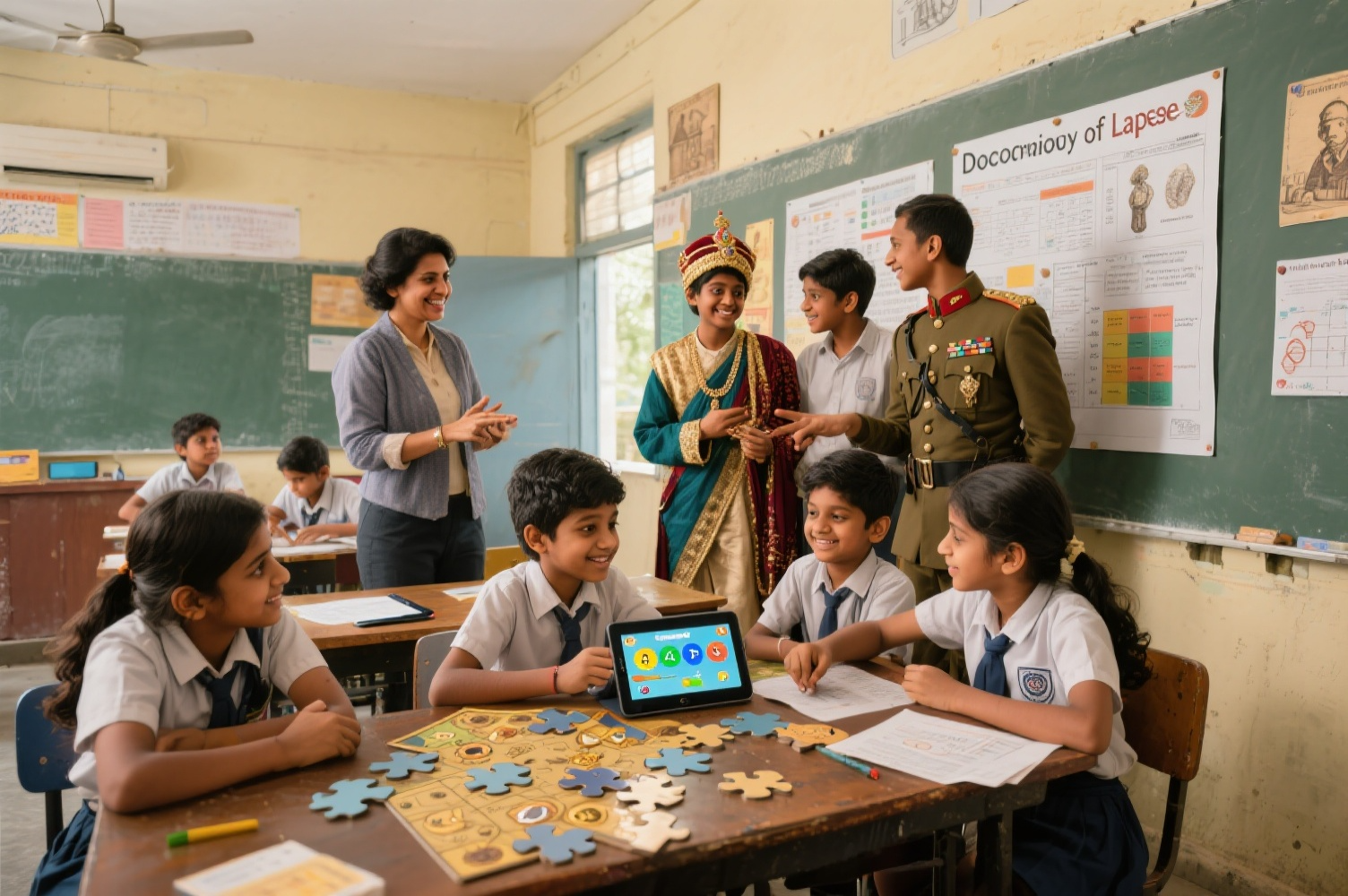- December 8, 2023
- by Educational Initiatives
- Blog
- 0 Comments
Background
Anybody who has ever taught in a formal teaching capacity would agree with me when I say that teaching is one of the most complex and difficult tasks that one can do. Add to that the complexities and nuances of a historical topic like the Doctrine of Lapse for grade 8 students. Recalling one such incidence, I took up this challenging task of facilitating a learning session on a complex topic without making it boring. I tried to teach this historical event by making the students role-play the events of mid-19th century that led to the implementation of the doctrine. One group of students played the role of the Indian princely states while the other played the role of the officials of the East India Company (EIC). They were given a small write-up about their situations and asked to interact with each other, keeping in mind the context of the roles they were playing. Thirty minutes later, amid the cacophony of arguments between the EIC officers and the Indian states, they were asked to settle down and reflect internally. The students were directed to think about how they acted, what motivated them to act in that manner, how it felt, was it justified, and was the Doctrine of Lapse fair for both parties. Once the reflection ended, the students couldn’t stop talking and discussing the events that had transpired more than a century and a half ago. They went back to their textbooks and now read it with their experiences of the role-play. Needless to say, none of the students who actively participated in that activity left without a deeper and far more internalized understanding of the historical event and its implications.
There are a number of unique things that stand out with respect to examples like these, especially in the context of the 21st century. The digital age that we live in makes it much easier for learners to access knowledge and factual information. With a click or two, you can read about anything under the Sun (and beyond it) — something that took months to access not more than half a century ago. Learners now can process information at a much higher capacity and pace. Hence, it is crucial that the learners are also taught in a manner that enables them to apply, analyse, critique, and evaluate that information rather than just remember or understand it. Those familiar with Bloom’s taxonomy would identify this as a deliberate shift towards developing the higher order thinking skills. If we look back at the way learners were taught half a century ago, we can see numerous similarities to how we still approach teaching in our formal education system. Why must we continue with something that is no longer relevant? The modern education system was designed to generate a steady flow of workers to serve and support the growing British empire without much independent thinking. It is surprising that we are still sticking with it, even when the times require people to create rather than serve.
With that being said, it is quite admirable to notice that the National Education Policy 2020 has taken cognizance of this matter and suggested an overhaul of how the learners of modern India should be taught. The policy talks in detail about putting emphasis on building relevant 21st century skills1, such as critical thinking, data literacy, communication, creativity etc. It has also ensured that the assessment frameworks align with this shift in focus. Therefore, its guidelines are crystal clear when it comes to assessing these skills purposefully and deliberately.
Exploring some effective teaching practices
Educators across the globe have designed many teaching methods and practices2 that develop the innate and natural curiousity, creativity, critical thinking, and problem-solving mindset of learners among many other skills necessary for them to succeed. Some of these are shared below. I would definitely encourage the reader to explore these methods in detail and research about other such strategies.
- Treasure Hunt – A treasure hunt is essentially a series of problems that students must solve in groups in order to achieve a final learning objective. These problems can be in the form of questions, puzzles, tasks, or a combination of all of them. Learners develop the essential skills of research, problem-solving, communication and perseverance. They also learn to work in challenging group dynamics and communicate with each other. This strategy has always been an instant success with every group of learners that I have implemented it with. I agree that it might require a bit more preparation on the teacher’s end to design the activity based on the learning objective. However, the outcomes in the form of student engagement and mastery, are usually that much more rewarding. It is commonly observed that subjects that are inherently objective and precise in their knowledge pieces (like physical sciences and mathematics) work quite well with a structure like treasure hunt. With the COVID-19 pandemic outbreak, some websites and applications have made it easier for the educators to create digital forms of such treasure hunts. At the same time, they allow educators to collect and analyse valuable student learning data. One such interesting example of using treasure hunt in a classroom can be accessed here – Mathematical Association (UK) Resource.
- Jigsaw – As the name suggests, this method works pretty much on the same principle as that of a standard jigsaw puzzle. A learning objective with its content is broken down into smaller pieces. These pieces are then shared with different learners of a group — each of them shouldering the responsibility of learning the assigned piece. The group then reconvenes to share what they have learnt — metaphorically putting the pieces of the puzzle together and creating a shared understanding where they can support, correct, question and challenge each other. The teacher conducts a combined debrief to ensure that learners have mastered the objective and bridge learning gaps if detected. Similar to a treasure hunt, the learners work together to build skills of collaboration, communication, research, synthesis and self-direction. Additionally, since the learning onus is shared by the learners directly, they also develop valuable skills of taking initiative, leadership, and adaptability. Subject areas that require learners to engage in a great deal of discussions and framing personal opinions (like literature and social sciences) pose as good candidates for a method like jigsaw. Many collaborative software like Google Docs, Notion, and Padlet provide the necessary and sufficient infrastructure to conduct jigsaws in digitally-distant learning environments. If you’d like to explore a jigsaw activity in detail, an example is shared here – Jigsaw example.
Peer review – This method focuses on students providing critical feedback and review on their peer’s work. Through this process, they learn to critically analyse their own learning. The teacher’s role is essential in designing an objective, unambiguous and comprehensive rubric for learners to refer to while they review their peer’s work. Unlike the previous two methods, I have noticed that many teachers implement some form of peer review system in their classrooms. Unfortunately, in most cases, it is restricted to correction of each other’s work. Peer review, in its true form, pushes students to develop and practice the highest levels of learning skills, i.e. synthesizing, evaluating, and creating, and hence it is one of the most powerful methods a teacher can employ in their classrooms. Online classroom management systems like Google Classrooms allow teachers to design and share rubrics with their students. An example of a rubric can be assessed here – Argument writing rubric.
Assessments as teaching practices
Many research studies have showcased the importance of conducting summative assessments at the end of the learning process to evaluate if the success metrics are aligned with learning outcomes. A few studies have also explored the importance of using formative assessments to not only evaluate, but also teach the concepts. The advancements in education technology in the past decade has been an outcome of such studies. Developed through foundational research on how students learn, Ei-Mindspark implements such technique to provide personalized and adaptive learning. The students interact with questions and activities of different learning levels and based on their responses, Mindspark identifies their misconceptions. Leveraging gamified interface and artificial intelligence, it then provides content designed for each student’s needs.
One of the latest additions to the Mindspark offerings are gamified learning modules. One of these gamified modules, Decimal Comparison Test, introduced a bunch of simple games that engage the students with the learning objectives without being lectured or explicitly tested, thus ensuring that the students learn in a manner that encourages essential 21st century skills like decision making and problem solving.

Another one called Name ‘em number is a game in Mindspark Maths that helps students learn to state numbers in words. This game has helped the Mindspark team to gain some amazing insights such as the unreported extent of misconceptions about the place values at higher primary grade levels even in the private schools. It has also broken some myths about the potential of students to learn beyond their grade level with the help of educational games.

In conclusion
Over centuries, our children have learnt the way that we needed them to learn. That, unfortunately, isn’t of much relevance now. We are now living in times when the world as we know it has been redefined and we should definitely implement teaching methods that reflect this. I believe it is only justified that I conclude the article with this quote from the American philanthropist and educator Ignacio Estrada,
If a child can’t learn the way we teach,
maybe we should teach the way they learn.
References
- 21st Century Skills: How can you prepare students for the new Global Economy? https://www.oecd.org/site/educeri21st/40756908.pdf
- Ismail Al-Rawi, Teaching Methodology and its Effects on Quality Learning. (https://core.ac.uk/download/pdf/234634129.pdf)



